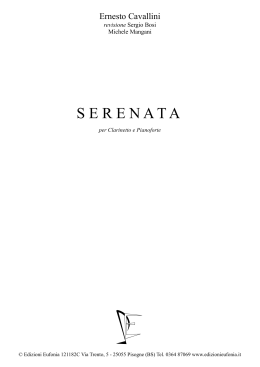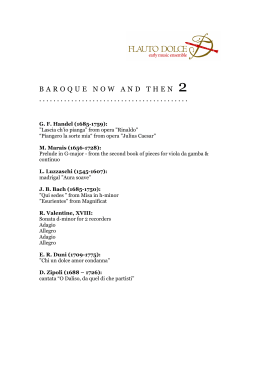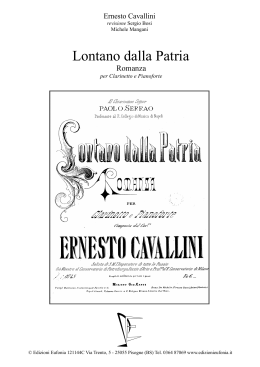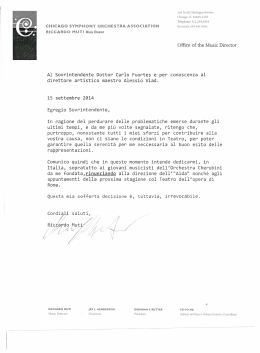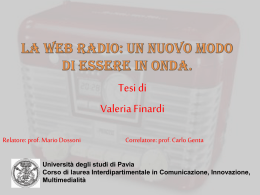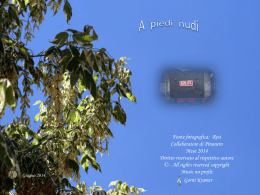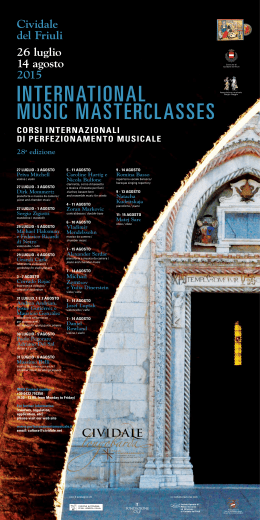Ernesto Cavallini revisione Sergio Bosi Michele Mangani Adagio e Tarantella per Clarinetto e Pianoforte © Edizioni Eufonia 131237C Via Trento, 5 - 25055 Pisogne (BS) Tel. 0364 87069 www.edizionieufonia.it “Conosci tu il paese dove fioriscono i limoni? Nel verde fogliame splendono arance d'oro Un vento lieve spira dal cielo azzurro Tranquillo è il mirto, sereno l'alloro.” Queste sono le parole che Goethe scrive a inizio Ottocento, di ritorno dal suo viaggio in Italia. Questa è l’Italia, idealizzata da tutti i viaggiatori che da secoli arrivano nel nostro Paese. Ma quale è la ‘vera’ Italia per coloro che vengono da Nord delle Alpi? Certo, Venezia (chi resiste a Venezia, la nobile decaduta?); certo Roma (chi non può strabiliarsi di fronte alle rovine di una storia ineguagliabile?). Ma soprattutto Napoli, perché, inevitabilmente e inesorabilmente, piace, affascina e attrae tutto ciò che a Nord delle Alpi non c’è: i limoni, le arance, il mirto, l’alloro, il sole e il mare (come il titolo di canzone napoletana). E piace il luogo di sogno dove tutto questo è radunato insieme, dove, per continuare con Goethe, ci sono i palazzi con le statue di marmo e dove “nelle spelonche dimora l'antica stirpe dei draghi e precipita la rupe sotto i flutti scroscianti”. È il Sud, da Napoli fino alla Sicilia, dove lo stesso Goethe arrivò (e forse scambiò per draghi i vulcani), sono quel mondo, quei colori e quelle suggestioni, mescolate alle mille svariate modalità della musica popolare, che si trasformano nella visione che il mondo ha dell’Italia e della sua musica. Da quel momento la letteratura strumentale europea si riempie di tarantelle e di barcarole, che prendono il posto, per i compositori dei diari di viaggio del gran tour: Mendelsson e Liszt, Čajkovskij, Rimskij-Korsakov e Borodin (per non citarne che alcuni) identificano l’Italia con Napoli, e riempiono salotti e sale da concerto di ‘suggestioni’ che condiscono di note i racconti di scrittori e poeti. Questa letteratura molto particolare si diffonde in Europa, ma consente anche di far rientrare dalla finestra la ‘musica strumentale italiana’, ormai tristemente uscita dalla porta. Concerto, Sonata e Sinfonia, erano infatti ormai dominio dalla cultura musicale centro europea (austriaca e tedesca); e anche l’opera, che nei due secoli precedenti aveva parlato italiano, col Romanticismo parlava ormai i linguaggi delle singole nazioni, anche se autori come Rossini e Verdi erano saliti a fama internazionale e amatissimi in tutto il mondo. Nello strapotere dell’opera, che nel nostro Paese nell’Ottocento non lascia che spazi interstiziali e quasi esoterici agli amanti del genere strumentale da camera e da concerto, i compositori di musica strumentale in Italia sono così quasi obbligati ad inventarsi percorsi sempre diversi lontani da quelle ‘grandi forme’ che da noi non avevano seguaci e, collocati in una sorta di “terra di mezzo”, riescono a costruire itinerari alternativi e affascinanti. Quello delle variazioni dai temi operistici più amati, ad esempio, per attirare verso lidi sconosciuti gli appassionati della musica teatrale; quello dei brani ‘da salotto’ capaci di soddisfare invece gli abili dilettanti, quello del virtuosismo estroverso e accattivante, per rapire il pubblico straniero e, infine, quello della ‘musica nazionale’ che, paradossalmente, proprio grazie ai viaggiatori, godeva di fama e popolarità e quindi poteva agevolmente trovare pubblico non solo in Italia ma, soprattutto, al di là delle Alpi. In questa posizione si colloca il milanese Ernesto Cavallini (1807-1874), clarinettista alla Scala e all’Opera di San Pietroburgo (è proprio pensando a lui che Verdi scrisse il celebre assolo della Forza del Destino), insegnante del suo strumento a Milano e in Russia e virtuoso a tal punto da essere ricordato con l‘appellativo di “Paganini del clarinetto”. Certo: il melodramma è cuore della sua vita artistica e della sua produzione musicale e i temi favoriti delle arie delle opere più famose diventano la base per le tante Fantasie e Variazioni del suo catalogo. Ma a questi si affiancano brani descrittivi e accattivanti, ed altri, come questo Adagio e Tarantella, che sembrano quasi la sintesi di tutto ciò che ci si aspettava, in quel momento, da un compositore italiano di musica strumentale. L’Adagio è quasi un preludio, fantastico e improvvisativo, cui segue un tema di andamento ‘quasi vocale’ che, nella mutevolezza armonica e nel continuo cambio di modo, punta a coinvolgere emotivamente l’ascoltatore fino alla cadenza che porta direttamente alla Tarantella. Qui il danzante ritmo ternario non è mai inutilmente e vanamente virtuosistico: è infatti il senso della gioia serena a prevalere fino al congedo, dove (inevitabilmente) entrano in gioco tutte le possibilità del virtuoso in una sorta di ‘fuoco d’artificio’, descrittivo e musicale insieme, degna conclusione di una festa piena di suoni e colori. Maria Chiara Mazzi “Do you know the land where the lemon blossoms grow? Among dark leaves the golden oranges glow. A gentle breeze blows from the blue sky. The myrtle is still, the laurel stands high.” These are the words that Goethe wrote at the beginning of the XIXth century coming back from his journey to Italy. This is Italy, idealised by all the travellers who have arrived in this country for centuries. But what is the ‘true’ Italy for those coming from North of the Alps? Of course, Venice (who can resist Venice, the downfallen noble?); then Rome (how can everyone feel but astonished seeing the ruins of an incomparable history?) . But mainly Naples because, inevitably and relentlessly, everything which cannot be found North of the Alps is what enchants, fascinates and attracts: lemons, oranges, myrtle, laurel, sun and sea (like the title of a Neapolitan song). And the dream place where all of this gathers together enchants, it is the place where, to say it with Goethe’s words, there are houses with marble statues and where “in caverns dwells the dragons' ancient brood and the cliff rocks plunge under the roaring waves”. The South, from Naples to Sicily, where Goethe himself arrived (and might have mixed up volcanos with dragons), that world, those colours and that fascination, together with the thousand different modalities of popular music, are the symbol of Italy and its music worldwide. From that time European instrumental literature has been filled up with tarantelle and barcarole. The composers of the travel journals of the grand tour, for example Mendelsson and Liszt, Čajkovskij, Rimskij-Korsakov and Borodin (just to mention some of them) identify Italy with Naples and fill lounges and concert halls with a ‘fascination’ which dresses the tales of writers and poets with notes. This distintive literature spread in Europe, but it also allowed the return of the ‘Italian instrumental music’, which had sadly been off stage. In fact by then Concerto, Sonata and Sinfonia were dominated by middle European music culture (Austrian and German); and during Romanticism also opera, which had been talking Italian in the two previous centuries, was talking the languages of the single nations, even if authors like Rossini and Verdi had become famous and beloved all over the world. In Italy in the XIXth century opera has an excessive power, which left only tiny and rather hidden spaces to the lovers of concerto and chamber music. Taking this power into account, Italian instrumental music composers were therefore almost obliged to follow always changing paths far from those ‘great forms’ which had no followers in Italy. Those composers, situated in a sort of “middle earth”, succeeded in creating unconventional and charming itineraries. For example, variations of the most loved operatic themes, in order to attract theatre music lovers towards unknown shores; ‘lounge’ pieces which can satisfy skilful beginners; extrovert and captivating virtuosity, in order to delight the foreign public; and, eventually,‘national music’ that, paradoxically, exactly thanks to travellers, enjoyed fame and popularity and could, therefore, easily attract audiences not only in Italy but also, and even more, over the Alps. This is the position of the Milanese Ernesto Cavallini (1807-1874), clarinetist at La Scala and at the Opera of St.Petersbourg (Verdi wrote the famous solo of La Forza del Destino thinking of him), teacher of his instrument in Milan and in Russia and virtuoso to such an extent that he is remembered as the "Paganini of the clarinet". Of course, music drama lies at the heart of his artistic life and music production and the favourite themes of the most famous opera arie form the basis for the many Fantasie and Variazioni of his repertoire. But, together with them, there are descriptive and captivating pieces, and others, like this Adagio and Tarantella, which seem the synthesis of everything expected from an Italian instrumental music composer at that time. The Adagio is a fictional and improvisation-driven prelude, followed by a theme with an ‘almost vocal’ style. With its harmonious variability and continous change of mode, this theme aims at involving the hearer emotionally up to the cadence leading directly to Tarantella. Here the dancing ternary rhythm is never uselessly virtuoso: it is the sense of serene joy which prevails up to the leave, where (inevitably) all the possibilities of the virtuoso come into play in a sort of musical and descriptive ‘firework’, a suitable conclusion of a feast full of sounds and colours. Maria Chiara Mazzi Adagio e Tarantella per Clarinetto e Pianoforte Clarinetto in Si b b & b Maestoso c œ f œ œ œ. œ. œ œ œ œ. . œ œ œ œ. . . bb & b b c ww ww f ? b b b c ww ww b Maestoso Pianoforte b & b b & b bb a tempo rall. œœ œœ œœ œœ ww ww ? bb b b ww ww b & b œ œ . œ œ. œ œ œ œ œ œ œ œ œ œ œ . . #œ Œ Ó Œ Ó rall. . rall. a tempo . œ œ œ œ. œ œ . . œœ . œ œ œ œ œ œ œ #œ œ ‰ ® œ œ œ œ œ œ œ œ œ œ #œ œ œ œ. œ. œ. . . nœ f a tempo 3 Ernesto Cavallini revisione Sergio Bosi Michele Mangani 6 œ ‰ bb n œœ œœ & b b ‰ ≈ œœ œœ R ? b b b ‰ ≈ nn œœ œœ b R œ œ nœ # œ œr ≈ œœ œœ Œ Ó œœ œœ Œ Ó rall. œ œ œ rall. Ó Ó rall. ‰ . n œœœœ œœœœ R fœ œ ‰. œ œ R a tempo œœ œœ R œ ‰. œ R ‰. ≈ œœ œœ œ #œ œ œ œ œ œ œ œ œ. . n œ œ œ b œ. œ #œ nœ œ. n œ œ œ b œ œ œ. œ. œ b œ œ. œ. œ œ œ œ j‰ œ . . œ meno meno Œ f w w œœ œ œ œ n n œœ b b œœ œ n œœ œ b œœ b n œœœœ œœ œœ w w © Edizioni Eufonia 131237C Via Trento, 5 - 25055 Pisogne (BS) Tel. 0364 87069 www.edizionieufonia.it 5 b & b 9 j # œ ‰ œ œ œ. œ # œ n œ œ n œ œ b œ. œ n œ œ œ b œ œ œ œ œ œ œ œ . . . œ . œ p cresc. b b œj ‰ b & b n œœ œœ œ ? bb b w b w 12 & bb b & b 15 b & b bb œ & bb œ n œœ œ œ. œ. . œœœ œ. œ. œ œ œ œ #œ . . œ b œœ œ œœœœ œ n œ œ œœ œœ #œ œ un poco rall. un poco rall. j‰ œ œ œ œ a piacere bb &bb ∑ ? bb bb ∑ j‰ œœ nœ ‰ J œœ >œ n œœœ œ œ. # œ. œ œ œ . > w S n www w> j‰ œ œœ ? b b b n œœœ ‰ >œ b œ J 18 œ b b œœ w w > bw S ? b b b www b w > b & b bb œ n n œœ œœ œœ . . . œ. œ. œ. œ œ # œ œ accel. œ. # œ. œ œ œ . #œ f > w S n www w> . œ. œ. œ. . . œ œ œ #œ accel. deciso œ > bw S www w > œ œ. œ. . œœœ œ. œ. œ œœœ . . rall. . .œ œ œ œ œ œ œ. # œ. œ n œ n œ. b œ. œ œ # œ. n œ. # œ . . b œ n œ b œ œ œ œ # œ œ. . . œ b œ n œ œ. # œ. œ. œ. . . . j œœ ‰ Œ nœ J ‰ Œ Adagio cantabile œ œJ ‰ œ œJ ‰ ˙ p rall. œ Ó ∑ Ó ∑ œ œ œ œ œ ‰ œ œ ‰ œ œ . œ œ œ ≈ œ œ œ œ. J J œ. . . Œ j ‰ Œ j ‰ Œ j ‰ œj ‰ Œ œœ œœ œœ œ. . . . πj j j œ. œ œ œ Œ ‰Œ ‰ Œ ‰œ‰Œ œ. œ. œ. J Adagio cantabile Eufonia 1312372C . Œ j ‰ Œ j ‰ Œ j‰ n œœ œ œœ œœœ . . j j œ n œ Œ ‰ Œ ‰ Œ œœ ‰ n œœ œ. n œ. J. œ Œ Œ
Scarica
